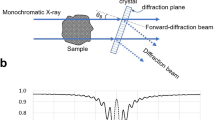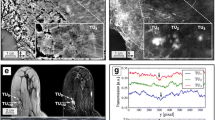Abstract
Objectives
We demonstrate the soft tissue discrimination capability of X-ray dark-field imaging (XDFI) using a variety of human tissue specimens.
Methods
The experimental setup for XDFI comprises an X-ray source, an asymmetrically cut Bragg-type monochromator-collimator (MC), a Laue-case angle analyser (LAA) and a CCD camera. The specimen is placed between the MC and the LAA. For the light source, we used the beamline BL14C on a 2.5-GeV storage ring in the KEK Photon Factory, Tsukuba, Japan.
Results
In the eye specimen, phase contrast images from XDFI were able to discriminate soft-tissue structures, such as the iris, separated by aqueous humour on both sides, which have nearly equal absorption. Superiority of XDFI in imaging soft tissue was further demonstrated with a diseased iliac artery containing atherosclerotic plaque and breast samples with benign and malignant tumours. XDFI on breast tumours discriminated between the normal and diseased terminal duct lobular unit and between invasive and in-situ cancer.
Conclusions
X-ray phase, as detected by XDFI, has superior contrast over absorption for soft tissue processes such as atherosclerotic plaque and breast cancer.
Key points
• X-ray dark field imaging (XDFI) can dramatically increase sensitivity of phase detection.
• XDFI can provide enhanced soft tissue discrimination.
• With XDFI, abnormal anatomy can be visualised with high spatial/contrast resolution.






Similar content being viewed by others
References
Webb S, Flower MA (2012) Webb's physics of medical imaging. CRC Press, London
Intl Commission on Radiation (1992) Photon, electron, proton and neutron interaction data for body tissues. ICRU Report 46
Schroeder S, Kopp AF, Baumbach A et al (2001) Noninvasive detection and evaluation of atherosclerotic coronary plaques with multislice computed tomography1. J Am Coll Cardiol 37:1430–1435
Chu B, Kampschulte A, Ferguson MS et al (2004) Hemorrhage in the atherosclerotic carotid plaque: a high-resolution MRI study. Stroke 35:1079–1084
Goehde SC, Hunold P, Vogt FM et al (2005) Full-body cardiovascular and tumor MRI for early detection of disease: feasibility and initial experience in 298 subjects. Am J Roentgenol 184:598–611
Bonse U, Hart M (1965) An X-ray interferometer. Appl Phys Lett 6:155–156
Momose A (1995) Demonstration of phase-contrast X-ray computed tomography using an X-ray interferometer. Nucl Instrum Methods A 352:622–628
Chapman D, Thomlinson W, Johnston R et al (1997) Diffraction enhanced x-ray imaging. Phys med biol 42:2015
Wilkins S, Gureyev T, Gao D, Pogany A, Stevenson A (1996) Phase-contrast imaging using polychromatic hard X-rays. Nature 384:335–338
David C, Nohammer B, Solak HH, Ziegler E (2002) Differential x-ray phase contrast imaging using a shearing interferometer. Appl Phys Lett 81:3287–3289
Wen H, Bennett EE, Hegedus MM, Carroll SC (2008) Spatial harmonic imaging of x-ray scattering—initial results. IEEE Trans Med Imaging 27:997–1002
Olivo A, Arfelli F, Cantatore G et al (2001) An innovative digital imaging set-up allowing a low-dose approach to phase contrast applications in the medical field. Med phys 28:1610
Momose A, Kawamoto S, Koyama I, Hamaishi Y, Takai K, Suzuki Y (2003) Demonstration of X-ray Talbot interferometry. Jpn J Appl Phys 42:L866–L868
Pfeiffer F, Bech M, Bunk O et al (2008) Hard-X-ray dark-field imaging using a grating interferometer. Nat Mater 7:134–137
Pfeiffer F, Weitkamp T, Bunk O, David C (2006) Phase retrieval and differential phase-contrast imaging with low-brilliance X-ray sources. Nat Phys 2:258–261
Bravin A, Coan P, Suortti P (2013) X-ray phase-contrast imaging: from pre-clinical applications towards clinics. Phys Med Biol 58:R1
Keyriläinen J, Bravin A, Fernández M, Tenhunen M, Virkkunen P, Suortti P (2010) Phase-contrast X-ray imaging of breast. Acta Radiol 51:866–884
Wu Y, Hyodo K, Sunaguchi N, Yuasa T, Ando M (2013) Development of high sensitivity X-ray multiple-times-diffraction enhanced imaging (M-DEI) optics(ed)^(eds) J Phys Conf Ser. IOP Publishing, pp 192008
Takagi S (1962) Dynamical theory of diffraction applicable to crystals with any kind of small distortion. Acta Crystallogr 15:1311–1312
Takagi S (1969) A dynamical theory of diffraction for a distorted crystal. J Phys Soc Jpn 26:1239–1253
Taupin D (1964) Dynamic theory of x-ray diffraction in crystals. Bull Soc Fr Mineral Crystallogr 87
Ando M, Maksimenko A, Sugiyama H, Pattanasiriwisawa W, Hyodo K, Uyama C (2002) Simple X-ray dark-and bright-field imaging using achromatic Laue optics. Jpn J Appl Phys 41:L1016–L1018
Kato N (1961) A theoretical study of pendellosung fringes. I. General considerations. Acta Crystallogr 14:526–532
Kato N (1961) A theoretical study of pendellosung fringes. II. Detailed discussion based upon a spherical wave theory. Acta Crystallogr 14:627–636
Donoho DL (2006) Compressed sensing. IEEE Trans Inf Theory 52:1289–1306
Candes EJ, Romberg JK, Tao T (2006) Stable signal recovery from incomplete and inaccurate measurements. Commun Pur Appl Math 59:1207–1223
Chapman D, Thomlinson W, Johnston R et al (1999) Diffraction enhanced x-ray imaging. Phys med biol 42:2015
Dilmanian F, Zhong Z, Ren B et al (2000) Computed tomography of x-ray index of refraction using the diffraction enhanced imaging method. Phys med biol 45:933
Maksimenko A, Ando M, Hiroshi S, Yuasa T (2005) Computed tomographic reconstruction based on x-ray refraction contrast. Appl phys lett 86:124105-124105-124103
Huang ZF, Kang KJ, Li Z, et al. (2006) Direct computed tomographic reconstruction for directional-derivative projections of computed tomography of diffraction enhanced imaging. Appl phys lett 89:041124-041124-041123
Sunaguchi N, Yuasa T, Huo Q, Ando M (2011) Convolution reconstruction algorithm for refraction-contrast computed tomography using a Laue-case analyzer for dark-field imaging. Opt lett 36:391–393
Sunaguchi N, Yuasa T, Huo Q, Ichihara S, Ando M (2010) X-ray refraction-contrast computed tomography images using dark-field imaging optics. Appl phys lett 97:153701-153701-153703
Ichihara S, Ando M, Maksimenko A et al (2008) 3-D reconstruction and virtual ductoscopy of high-grade ductal carcinoma in situ of the breast with casting type calcifications using refraction-based X-ray CT. Virchows Arch 452:41–47
Acknowledgments
The authors would like to thank Mr. Kazuki Matsui, Ms Megumi Yokoyama and Ms Mayumi Kataoka for their technical assistance, and Dr. Suzuko Moritani and Dr. Masaki Hasegawa for providing clinicopathological data. Valuable help in sample preparation and imaging was provided by Drs. Suzanne Lee, Kazuyuki Hyodo, Qingkai Huo, Ms. Andrea Schmitz and Mr. Yuki Nakao. Computational calculation of the spatial resolution in XDFI was performed using the Takagi-Taupin theory by Dr. Yoshifumi Suzuki, to whom the authors would like to express their thanks. This work was supported, in part, by the DARPA AXiS program, grant no. N66001-11-4204, P.R. no. 1300217190. This research was also supported in part by a Grant-in-Aid for Scientific Research (no. 22591353) from the Ministry of Education, Culture, Sports, Science and Technology (MEXT) in Japan and in part by a Grant-in-Aid for Clinical Research from the National Hospital Organization. The experiment was performed under the approval of the PF User Association (PF-UA) at KEK under no. 2008S2-002, 2011G-672 for use of the Photon Factory.
Author information
Authors and Affiliations
Corresponding author
Rights and permissions
About this article
Cite this article
Ando, M., Sunaguchi, N., Wu, Y. et al. Crystal analyser-based X-ray phase contrast imaging in the dark field: implementation and evaluation using excised tissue specimens. Eur Radiol 24, 423–433 (2014). https://doi.org/10.1007/s00330-013-3021-9
Received:
Revised:
Accepted:
Published:
Issue Date:
DOI: https://doi.org/10.1007/s00330-013-3021-9




